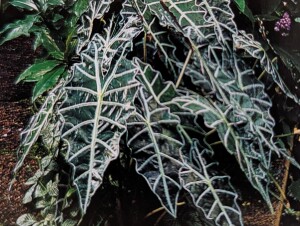 It may not be obvious, but elephants are rampaging in our homes and gardens. Large and impressive, they fill spaces with life and texture in exchange for ready supplies of food and water. The one thing they don’t do is awaken the neighbors with noisy trumpeting. This is clearly a blessing, especially if you live in close quarters.
It may not be obvious, but elephants are rampaging in our homes and gardens. Large and impressive, they fill spaces with life and texture in exchange for ready supplies of food and water. The one thing they don’t do is awaken the neighbors with noisy trumpeting. This is clearly a blessing, especially if you live in close quarters.
The “elephants” in question are hybrids and cultivated varieties of alocasia and Colocasia esculenta, most often known as “elephant ears”. The vogue for large-scale, tropical foliage plants has resulted in a stampede of these particular elephants. Like their animal namesakes, they make quite an impression.
First, the basics. Elephant ears are known for their plentiful, large—sometimes very large—leaves that are generally heart or arrowhead-shaped and may more than 12 inches long and 18 inches wide on plants that can be four to five feet tall and wide. Some commercial varieties may be smaller, so it pays to check plant tags and other information. There are exceptions, but generally alocasia leaf tips point upwards, while colocasia leaf tips point down. If you start the plants from tubers, which are sometimes erroneously referred to as “bulbs”, there are also differences. Colocasia tubers have stripes; the somewhat smaller alocasia tubers do not. Tubers of both types have been compared to dinosaur eggs.
Colocasia is sometimes called “taro”, and when cooked and processed, is the basis of a traditional Polynesian dish. In the raw state, all the parts of both alocasia and colcasia are poisonous to humans and animals.
Both colocasia and alocasia make great accents on patios or in pool areas, and can also be grouped together and used for screening purposes. The plants generally grow in full sun to part shade. Colocasia does best in consistently moist soil, while alocasia can get along with a bit less moisture. If you are trying to choose between the two, it pays to think about how much moisture is likely to be present in the growing situation, especially for containerized plants where a human being will be supplying the moisture.
If you are planning a rain garden, colocasia makes a good, dramatic choice.
Selecting your “elephant” may be the hardest part. If you want to go basic and opt for giant green leaves, pick a variety like Alocasia ‘Jumbo’, or Alocasia ‘Sarian’ which, left to their own devices, can grow up to ten feet tall with a bumper crop of wavy-edged green leaves. Colocasia ‘Hawaian Punch’, has the same green leaves, but produces those leaves on bold pink stems.
For still more color, pick one of the mottled or variegated varieties, like the currently popular ‘Hilo Beauty’, an alocasia that grows to a mere three feet and bears black stems and leaves splashed with chartreuse. Colocasia ‘Mojito’ is also mottled, but the splashes on the big green leaves are near-black.
Unadorned black is a dramatic color in the garden, and if that kind of drama resonates, colocasia varieties like ‘Black Magic’, ‘Diamond Head’ and the ginormous ‘Jumbo Diamond Head’, all with black leaves, will be perfect.
If you are dying for your own elephant menagerie, you can buy the plants one of two ways. Some vendors offer young plants in containers, in which case, all you have to do is transplant into larger vessels or into the ground after all danger of frost has past and night temperatures do not fall below 50 degrees Fahrenheit. Situate your elephant or elephant herd in part shade to full sun. If you notice leaves starting to look singed around the edges, move to a shadier spot.
Buying tubers is cheaper and the selection is sometimes greater. If you choose to start from tubers, order them now, and plant about five inches deep in standard potting mix. They will grow rapidly, especially outdoors in the warm summer months. Fueling that rapid growth is important, so use a general purpose plant food, applied according to manufacturers’ directions.
Unfortunately, elephants and snow do not mix, so your plants need to winter indoors in bright, indirect light. The same goes for colocasia and alocasia that spend their entire lives indoors. Winter is a dormant or semi dormant season for the plants, so do not be disappointed when growth slows dramatically. Both you and the plants need a period of rest.
If you don’t have room to overwinter your elephant ears, you can lift the bulbs in the fall after the first frost. Let bulbs and foliage dry off on a sheet of newsprint or other paper, then cut off the spent foliage and store the bulbs in a cool, dry place. Replant them in the spring.
Local merchandisers may carry one or two varieties of elephant ears. For tubers, try Eden Brothers, 2099 Brevard Road, Arden, NC 28704, (855) 440-2929; www.edenbrothers.com. Plant Delights Nursery carries an excellent selection of potted starter plants. Find them at 9241 Sauls Rd, Raleigh, NC 27603; 919-772-4794; www.plantdelights.com. Print catalog available.
